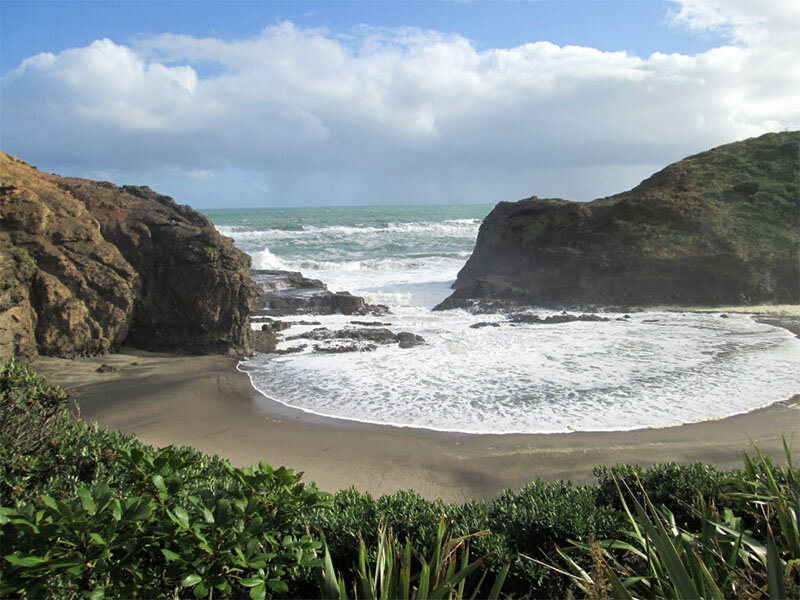New Zealand eludes me
Loading...
Among the responses to the pictures I’ve shared of a five-week sojourn through New Zealand, the most guilt-provoking were not the predictable bleats of envy, but one simple and pointed question: “Are you writing about this trip?”
I should be gushing words, I thought, as I took in sweeping views of snowcapped peaks and plunging gorges from my seat
on the TranzAlpine rail link from Christchurch to Greymouth. But New Zealand stunned and overwhelmed me. And volumes have been written already about its unique ecosystems, landscapes, geology, and geography. What more could I add to describe those ethereal landscapes formed and transformed by actively steaming, bubbling, and erupting thermal springs?
Compounding my writer’s block was an element of mind-numbing terror, especially in the first week, before I became halfway comfortable with the islands’
narrow, twisting roads. Miles and miles of narrow tarmac hugged coastal cliffs and switchbacked up and down mountains, with occasional lane-wide washouts. Directional prompts from our Kiwi-
accented GPS device were of little use. After it instructed us to turn left, straight
over a precipice, we shut it off and simply followed the curving contours. Sheer drops regularly opened just past narrow or nonexistent shoulders. My advice to friends considering a visit: Forget saving money by hauling a trailer, and get where you plan to sleep before dark.
My pen was as dry as my mouth. If eye contact with a humpback whale (I was on a boat off the coast of Kaikoura) couldn’t get the ink flowing, nothing would. I jotted notes each night before bed, but there seemed no way to sum things up, to distill a wealth of experience and vivid impressions into a journal entry or essay. That goal seemed as elusive as an encounter with the endangered and nocturnal kiwi, which even many New Zealanders have never seen in the wild.
What, other than those roads, was the thread connecting the whole experience for me?
It turned out to be another small, brown indigenous bird. We noticed our first fantail early on, during a beach stop on a boat tour of Tasman Bay inlets. It perched close by on a wooden post and eyed us, as if awaiting our next move. And that is exactly what it was doing. When we struck off, it followed in our footsteps, all but brushing our shoe tops, twisting and twirling in bursts of flight, sometimes just behind us, sometimes ushering us onward. Every so often – at impossible-to-predict intervals – it briefly fanned its tail feathers out in a wide arc, as if in greeting.
From that point on we saw them everywhere – fantails flitted in and out of the clouds of steam rising from geothermal parks, followed us along beaches, and appeared in force along any grassy paths we tramped. It wasn’t that they liked us, we learned; we merely provided their meals by disturbing ground insects into flight. The pivotal action of that wide tail was no greeting, but a rudder. It allowed for quick turns and swivels in pursuit of a snack.
Even knowing all this I found the bird an entrancing and dependable companion in my travels about the islands, the creature that grounded me in New Zealand and made it home for a time in a small but significant way. And so, while I’d posted legions of pictures of dramatic land and seascapes, I determined to capture a photo of this humble brown bird, so reminiscent of (and exotic to) the Carolina wren back home. I set my sights on a snapshot of it flying or perching with a wide-open tail.
As if knowing what I wanted, fantails regularly swooped to a stop momentarily before me and posed, tails spread. One even led my way through a deadfall along a trail, perching from opening to opening, egging me on through the tangle. Day after day I pulled my camera from my vest pocket, focusing and clicking with abandon, ever hopeful of a truly representative shot.
Many dozens of images later – most of foliage or grass, with a blurred edge of a wing or the tip of a streamlined tail – I admitted defeat and simply enjoyed the company of these Kiwi icons. They had become New Zealand to me. And it was oddly appropriate that I couldn’t quite capture what they were all about.







